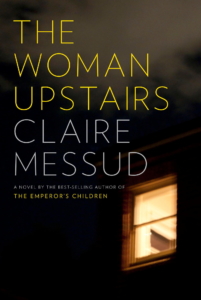In her mid-thirties, Nora Eldridge, the protagonist of Claire Messud’s latest novel The Woman Upstairs, is an elementary school teacher in Cambridge, Massachusetts. She is single and childless and lives, as she says, as if on a “treadmill of the ordinary, a cage built of convention and consumerism and obligation and fear.” She used to entertain dreams of becoming an artist and fulfilling her creative potential. Alas, time got away from her. Now, she associates those distant dreams as symptoms of an illusion called the “Fun House,” a sucker’s mixed-up paradise full of aspirational delusions and the anticipation of something better to come; a sort of existential credit card that always leaves room for optimism. Not that Nora’s worldview is so terribly bleak — her thoughts burn with Plathian vigor; by turns, ferocious and hilarious. She wears her snarky enlightenment proudly and like armor, scoffing at those who see things differently.
Her inner monologue makes up the bulk of the story, which spans the roughly three-year duration of her acquaintance with the Shahid family — Sirena, a seductively full-of-life Italian artist, her husband Skandar, a professor from Lebanon completing a fellowship at Harvard, and their son, Reza, who is one of Nora’s third graders. Nora first becomes involved with the family when Sirena is called in to school following a bullying incident where Reza is the victim. Sirena’s self-possession and cool demeanor disarm Nora, as does Reza’s endearing shyness. Nora takes an immediate liking to them, which only increases as she begins to learn more about their worldliness relative to hers. She starts to study them and analyze every detail of their existence. Her displays of friendship toward them are calculated and amount to a strategy for ingratiating herself. Without too much effort on her part, they welcome her. She thrives off the intensity of their multi-cultural, intellectual and creative world, at times confusing it with her own. All the while, she is resolute in her inferiority and awe — the invisible woman; the woman upstairs — but continues to crave and consume their energy, as if it were crucial to her survival.
The muse-like presence of Sirena in Nora’s life awakens her latent artistic drive and they decide to split a rental studio space together. But, for someone so desperate to make art and have it be exploratory and meaningful, her creative process appears to revolve more around her obsession with Sirena and Sirena’s video artwork than clarity in her own ideas. The great opus to which she soon devotes all of her spare time — a project she calls “Emily’s House”— is a dollhouse replica of Emily Dickinson’s home in Amherst, MA, where the poet was born and lived for most of her life. Somewhat incongruous is Nora’s simultaneous idolization of Warhol superstar Edie Sedgwick, who is often cited for her image-obsession and her vapidity. Messud’s choices for Nora’s artistic inspiration are perhaps meant to show Nora’s phoniness, or rather, her neoteny, further revealed by her non-maternal obsession with Reza, her child-like angst, and her need to be “taken in” by the Shahids.
Nora’s own family does appear at times, in flashbacks. We learn that her mother was a repressed Eisenhower-era housewife who wanted more. Nora blames her mother for setting this example, and though she doesn’t look back on her affectionately, she seems to have been unprepared to live in the world without her, and resents her for “leaving.” Her mother’s dying words explicitly charge Nora to let go of the things that paralyse her, and live deliberately. Nora carries this message around as merely another weight, or pressure to follow someone else’s prescriptions for happiness. Its purpose is defeated in how much it bogs her down.
Her mind, on the subject of herself and others alike, is a tedious worm-hole of disquietude, and while Messud’s rendering of it eventually builds to the novel’s exquisite twist ending, it can be a drag to inhabit along the way. A treatise on repressed creativity, voyeurism, obsession, and misanthropy, The Woman Upstairs is an exhausting ego-trip to behold. Nora’s observations of the world around her — in which fulfillment belongs to everyone but her — are believably symptomatic of her particular type of pathology at stunted middle-age: she is in a perpetual state of coveting what others have — a sense of vitality and engagement — but denies herself any proactive measure, for fear of dabbling in “Fun House” mentality.
In this apt reflection on self-awareness and interpersonal connection lies her ultimate hangup: “It’s the strangest thing about being human: to know so much, to communicate so much, and yet always fall so drastically short of clarity, to be, in the end, so isolate and inadequate.” This defining quote seems to sum up Messud’s intention with the novel. Nora’s neurosis and self-obsession are all we see. Her speculation over how the Shahids view her, rather than their own views, are the only facts we have to consider. Messud exploits this extreme bias in order to demonstrate how dangerous and alienating such a need-to-connect can be.
Messud allows Nora to flail, and wallow, and strain, and does so without a spec of reproach. Though Nora frequently humiliates herself, those occasions are, for the most part, neither cringe-worthy nor pitiful. Messud’s expression of Nora’s unlikely self-confidence in her tragedy is a testament to her achievement in conceiving of Nora’s dynamism.
This post may contain affiliate links.









